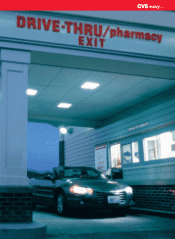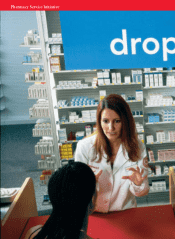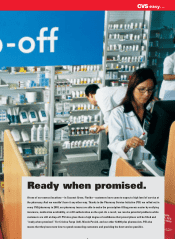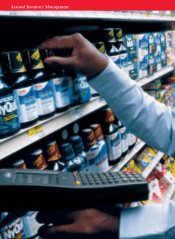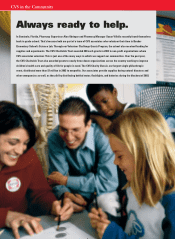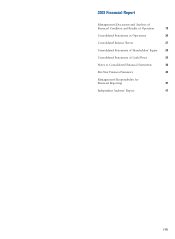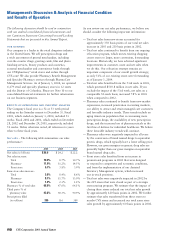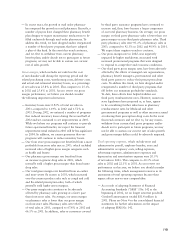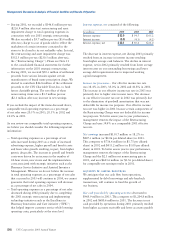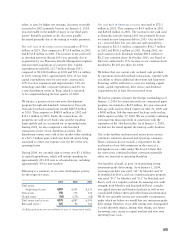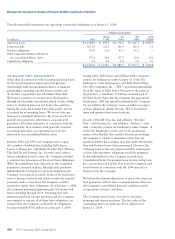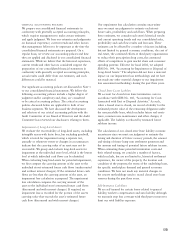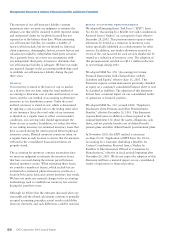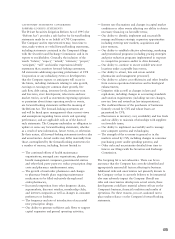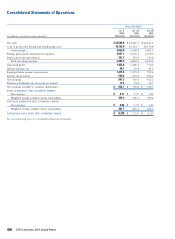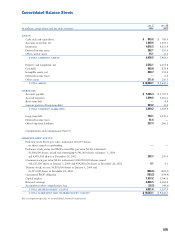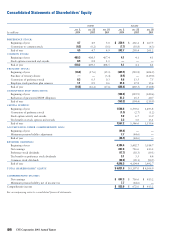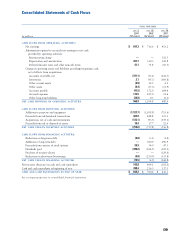CVS 2003 Annual Report Download - page 21
Download and view the complete annual report
Please find page 21 of the 2003 CVS annual report below. You can navigate through the pages in the report by either clicking on the pages listed below, or by using the keyword search tool below to find specific information within the annual report.(19)
—In recent years, the growth in mail order pharmacy
has outpaced the growth in retail pharmacy. Recently, a
number of payors have changed their pharmacy benefit
plan designs to require maintenance medications to be
filled exclusively through mail order pharmacies. To
address this trend, we have dropped and/or renegotiated
a number of third party programs that have adopted
a plan of this kind. In the event this trend continues,
and we elect to withdraw from current pharmacy
benefit plans, and/or decide not to participate in future
programs, we may not be able to sustain our current
rate of sales growth.
Gross margin, which includes net sales less the cost
of merchandise sold during the reporting period and the
related purchasing costs, warehousing costs, delivery costs
and actual and estimated inventory losses, as a percentage
of net sales was 25.8% in 2003. This compares to 25.1%
in 2002 and 25.6% in 2001. As you review our gross
margin performance, we believe you should consider
the following important information:
—Inventory losses were 0.92% of total net sales in
2003, compared to 1.19% in 2002 and 1.52% in
2001. During 2002, we initiated a number of programs
that reduced inventory losses during the second half of
2002 and we continued to see improvements in 2003.
While we believe our programs will continue to provide
future operational benefits, we expect the financial
improvement trend realized in 2003 will be less significant
in 2004. In addition, we cannot guarantee that our
programs will continue to reduce inventory losses.
—Our front store gross margin rate benefited from a more
profitable front store sales mix in 2003, which included
increased sales of higher gross margin categories such
as health and beauty.
—Our pharmacy gross margin rate benefited from
an increase in generic drug sales in 2003, which
normally yield a higher gross margin than brand name
drug sales.
—Our total gross margin rate benefited from an earlier
and more severe flu season in 2003, which increased
over-the-counter product sales such as cough and cold
and flu-related prescription sales, both of which
generally yield higher gross margins.
—Our gross margin rate continues to be adversely
affected by pharmacy sales growing at a faster pace
than front store sales. On average, our gross margin
on pharmacy sales is lower than our gross margin
on front store sales. Pharmacy sales were 68.8%
of total sales in 2003, compared to 67.6% in 2002 and
66.1% in 2001. In addition, sales to customers covered
by third party insurance programs have continued to
increase and, thus, have become a larger component
of our total pharmacy business. On average, our gross
margin on third party pharmacy sales is lower than our
gross margin on non-third party pharmacy sales. Third
party pharmacy sales were 93.2% of pharmacy sales in
2003, compared to 92.3% in 2002 and 90.9% in 2001.
We expect these negative trends to continue.
—Our gross margin rate in 2002, was negatively
impacted by higher markdowns associated with
increased promotional programs that were designed
to respond to competitive and economic conditions.
—Our third party gross margin rates have been adversely
affected by the efforts of managed care organizations,
pharmacy benefit managers, governmental and other
third party payors to reduce their prescription drug
costs. To address this trend, we have dropped and/or
renegotiated a number of third party programs that
fell below our minimum profitability standards.
To date, these efforts have helped stabilize our
third party reimbursement rates. However, numerous
state legislatures have proposed or, at least, appear
to be considering further reductions in pharmacy
reimbursement rates for Medicaid and other
governmental programs as well as other measures aimed
at reducing their prescription drug costs. In the event
this trend continues and we elect to, for any reason,
withdraw from current third party programs and/or
decide not to participate in future programs, we may
not be able to sustain our current rate of sales growth
and gross margin dollars could be adversely impacted.
Total operating expenses, which include store and
administrative payroll, employee benefits, store and
administrative occupancy costs, selling expenses,
advertising expenses, administrative expenses and
depreciation and amortization expense were 20.5%
of net sales in 2003. This compares to 20.1% of net
sales in 2002 and 22.1% in 2001. As you review our
performance in this area, we believe you should consider
the following items, which management removes in its
assessment of total operating expenses because their
impact affects year-to-year comparability:
—As a result of adopting Statement of Financial
Accounting Standards (“SFAS”) No. 142 at the
beginning of 2002, we no longer amortize goodwill.
Goodwill amortization totaled $31.4 million in
2001. Please see Note 4 to the consolidated financial
statements for further information on the impact
of adopting SFAS No. 142.


